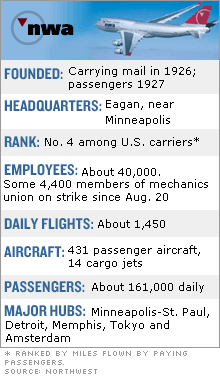Jumpseatnews.com - United Airlines flight attendant resources
Northwest Files For Bankruptcy
High fuel prices, inability to win union wage concessions force bankruptcy at No. 4 carrier.
 NEW YORK (CNN/Money) - Northwest Airlines filed for bankruptcy Wednesday, hit by a spike in jet fuel prices and an inability to win wage concessions from its unions, about a half hour after rival Delta also filed for Chaper 11 protection.
NEW YORK (CNN/Money) - Northwest Airlines filed for bankruptcy Wednesday, hit by a spike in jet fuel prices and an inability to win wage concessions from its unions, about a half hour after rival Delta also filed for Chaper 11 protection.
The twin filings mean four of the nation's major airlines are operating under protection from creditors.
Northwest had been flying for nearly a month with its unionized mechanics on strike and is expected to maintain its normal flight schedule in bankruptcy, limiting the impact on flyers.
Northwest follows No. 2 United Airlines (Research), US Airways (Research) and now Delta into bankruptcy. The shocks of the Sept. 11 terrorist attacks, and now Hurricane Katrina, which sent jet fuel prices soaring, were a double blow to the industry.
Northwest filed for protection under Chapter 11 of the bankruptcy code, under which a company is protected from creditors as it seeks to cut costs and reorganize.
Despite filing for bankruptcy, Northwest is generally seen as being in better financial shape than Delta.
Despite filing for bankruptcy, Northwest is generally seen as being in better financial shape than Delta. As late as Tuesday afternoon, some analysts had been saying it might avoid bankruptcy altogether.
The most recent financial report from Northwest showed it had $2.1 billion in cash on hand as of June 30. While that's down from $2.5 billion at the end of 2004, it's well above the $1.7 billion in cash and short-term investments its larger rival Delta showed on its balance sheet.
But Northwest has been playing hardball with its unions. It virtually pushed its union mechanics into a strike, making an offer calling for 25 percent pay cuts and slashing half of the union's jobs at the carrier. It had 1,200 replacement workers, as well as managers and outside contractors, ready to do the union's work as soon as the strike started.
The bankruptcy filing gives Northwest a chance to force unions representing pilots, flight attendants and other ground workers to accept deep pay cuts. Northwest said earlier this year it needed an additional $1.1 billion in labor cost savings to avoid bankruptcy. It recently warned that the spike in fuel prices meant $1.1 billion wasn't enough to avoid bankruptcy.
The filing also gives Northwest a chance to dump some of its pension obligations on the federal agency that guarantees private pension plans. Its most recent filing showed Northwest faced a $3.8 billion shortfall in its pension plans, and it had been pushing for new laws to give it more time to cover the gap.
Experts said one other factor may have pushed Northwest: a change in bankruptcy laws due to take effect Oct. 17. Under the new law, Northwest management would have only 18 months to work out a reorganization plan without competing plans from creditors. United has gone for nearly three years without facing such a challenge in its bankruptcy proceedings under existing law.
But experts also agreed that the soaring price of jet fuel was a major factor. Northwest said in its bankruptcy announcement that it now expects that its fuel bill for 2005 will be approximately $3.3 billion. This compares with $2.2 billion for 2004 and $1.6 billion for 2003.
"Those three factors, pension, labor and fuel prices, likely were the major considerations," Philip Baggaley, Standard & Poor's senior airline credit analyst, said in comments before the Northwest filing.
Northwest also faced growing competition from low-fare, lower-cost carriers, which has hurt major hub-and-spoke carriers such as American Airlines, the No. 1 airline, and the other airlines in bankruptcy.
The stiff competition has helped keep airfares lower than necessary to cover current fuel costs. Northwest's average fare per mile flow slipped 1.7 percent in the first half of the year, even as fuel costs soared.
But Northwest, with a greater percentage of its traffic coming from overseas routes, was somewhat less affected than some of its peers by the growth of the low-fare carriers, which operate almost exclusively domestic routes.
< Return to Latest News
Quick Find
- Unimatic Access
- CCS | Bid Packages
- Flying Together | Webmail
- EmployeeRES | Fare Calculator
- Forms | Paychecks | Benefits | Discounts
- ANP | Leave of Absence | eLearning | CQ
- PED Supplement
- Briefing Sheets | Purser | Tools | FAOM
- Uniforms: Info | Order | Tailors
- Phone Directory | Medical | W2 Form
Travel and Safety
- EmployeeRES | Fare Calculator
- Edit Your Pass Riders | Get Reports
- Jumpseat Travel
- Visas/Passports | Policies | Companions
- Reciprocal Cabin Agreements | ZED
- Known Crewmember | IOR